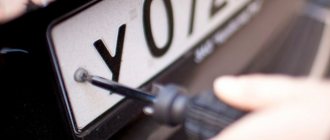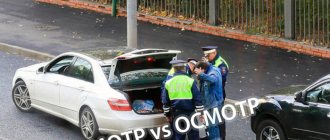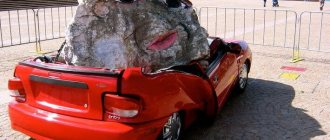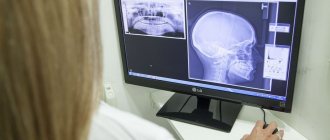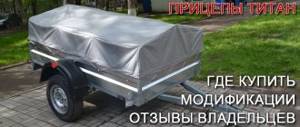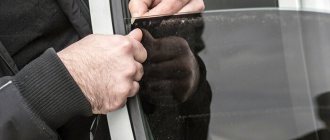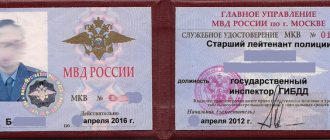Many motorists have always believed that the traffic police can stop motorists only at stationary checkpoints in accordance with Order of the Ministry of Internal Affairs No. 185. But it does not indicate where the inspector can stop the car. The Order only puts into effect the Administrative Regulations, which must be referred to on this issue. At the time of writing this review in 2021, there are no changes to this order.
The regulations may change and be adjusted. The updated version came into force in 2021, and a new Order of the Ministry of Internal Affairs No. 664 was issued for its approval. The new version of the regulations includes a condition under which it is possible to check the documents of drivers outside a stationary post. Let's figure out what reasons exist for this.
- Stop grounds
- Is the traffic police inspector required to show orientation?
- How can you stop a car?
- Procedure for checking documents
- What are they checking on foreigners?
- Conclusion
Stop grounds
The new version of the law gives the traffic police inspector the right to stop a car driver on the road not at a stationary post, but at any place in order to check documents. However, the inspector cannot choose such a place on his own; for this he needs an order from his superiors. These changes regarding stopping outside a stationary post were made due to a large reduction in traffic police posts. This, in turn, is due to the massive reduction of employees of the State Traffic Inspectorate.
In fact, inspectors were previously able to stop vehicles in any place if special events were being carried out. Therefore, the new order changed almost nothing, especially in urban areas. Inspectors will easily find the reason for the stop, and drivers usually do not argue with them. After all, it’s easier to get and show your license and compulsory motor liability insurance policy than to enter into disputes with the police, which will cost you more.
Service areas for inspectors are established by analyzing the accident rate in a given area, identifying dangerous places, difficult road conditions, and operational reports. The regulations prohibit the inspector from smoking while communicating with the driver, oblige him not to be rude, to be polite, and to refrain from discrimination of various kinds. You cannot make unlawful accusations or insult.
You can stop for the following reasons:
- Violation of traffic rules, which is recorded by technical means or visually.
- Information about the involvement of the driver or passengers in a crime or accident was received.
- There is information about the theft or search for a car.
- The driver is a witness to an accident, a crime, stopped to give evidence.
- Participation of witnesses.
- The police officers urgently needed a car.
- Prohibition or restriction of vehicle movement.
- Ensuring unhindered and safe passage for special services vehicles.
- Providing assistance by the driver to other road users or the police.
- Carrying out an event, execution according to special orders.
- Scheduled check. The car is checked for being wanted, transporting prohibited substances, or wanted people.
- Threat to traffic safety due to breakdown of technical equipment, road works, man-made accidents, natural disasters, emergencies.
- To check documents: driver’s license, for cargo transportation.
- Suspicions on the wanted list, participation of the driver in the crime.
Now there is no point by which documents could be checked at stationary posts. Therefore, the inspector can stop the vehicle to check documents anywhere. But this should happen if there is a basis for verification.
The difference between the two Orders 185 and 664 is that the grounds for the stop were previously stated. This was wrong. But the first point is that the signs of a violation, according to the inspector’s suspicions, are the testimony of witnesses and landmarks. If he received an indication on the road that a certain car was involved in a crime, then the inspector would have every reason to stop him.
Special events are also a good reason to stop at a non-static post. This applies to the following events: “sober driver”, “child safety” and others.
In what cases may the inspector ask you to open the trunk?
Russian legislation strictly regulates the procedure for checking cars, and no one has the right to inspect a car “just like that.” Lawyer Anton Bibarov-Gosudarev told aif.ru about how to behave if a traffic police inspector insists on an inspection.
What can serve as a reason for inspecting a car? For example, if the driver committed any violation of traffic rules and was stopped by the traffic police crew: he exceeded the speed or turned in the wrong place. If at the same time the person does not behave quite adequately, then the inspector will most likely begin an inspection or search.
A traffic police officer may ask to see a first aid kit or fire extinguisher. Most drivers have them in the trunk, so the inspector will in any case see other things that are there. This is not yet an inspection. But if the driver refuses to present a first aid kit or fire extinguisher, the crew will have a legal reason to begin a full search. This is stated in Article 27.9 of the Code of Administrative Offenses of the Russian Federation.
So what is the difference between a car inspection and a vehicle search? The federal law “On Police” states that an inspection is a visual examination of the vehicle and the cargo being transported. The participation of witnesses in this procedure is not necessary. The car owner independently opens the hood, trunk, and glove compartment of the car. If necessary, an inspection report is drawn up in any form.
If the driver refuses, the inspector can begin the inspection procedure. This is an inspection of the car, during which its structural integrity is not compromised. The search is accompanied by two witnesses. The car owner has the right to record what is happening on a video camera.
When a traffic police inspector stopped a vehicle and asked to open the trunk, he must present his service ID before doing so. All data should be remembered. If he has begun the inspection procedure, then it is worth asking him to draw up a protocol in accordance with Article 27.9 of the Code of Administrative Offenses of the Russian Federation and invite two witnesses. As an alternative, video recording can be done. You need to act as politely and correctly as possible so that the inspector does not have doubts about the adequacy of the driver.
It is better to demonstrate things to which the inspector has shown interest yourself. But he has the right to touch property in the presence of witnesses and with the video camera turned on.
If the inspector allows arbitrariness - for example, he began the inspection procedure without drawing up a protocol - it is worth trying to call on witnesses for help. These could be pedestrians or drivers of passing cars. Incorrect actions of a police officer may be grounds for a further complaint to the traffic police.
How can you stop a car?
To stop a car on the road, the traffic police inspector makes a special gesture. The request to stop can be made using a loudspeaker or by hand. In addition, a traffic police officer can use a disk with a red glowing signal or a rod. The inspector shows a place to stop the car. At night, the signal is given by light signals, if possible.
The inspector does not have the right to stop the car in places where this is prohibited according to the Traffic Rules. However, there are exceptions. For example, a driver was stopped to help stop a crime or cause harm to health.
Rights and responsibilities of an inspector after a stop
After the car has stopped at the request of the traffic police inspector, he is obliged to:
- Approach the driver without delay.
- Say hello, name your title, position, last name, first name, patronymic.
- When addressing the car owner, place your right hand on the headdress.
- State the reason for stopping.
- Show your driver's identification card upon request. Don't forget to write down the employee's details on the document.
- Demand to hand over documents without holding devices, remind the rights and obligations of the car owner if he is involved as a witness.
- Do not delay stopping time.
- Explain the essence of the offense, if it occurs.
In addition to his duties, the traffic police inspector has the right to ask the driver to get out of the car in the following situations:
- The driver showed signs of illness or intoxication.
- To conduct a personal search, inspection of a vehicle or cargo.
- To verify vehicle unit numbers with data in documents.
- If it is necessary for the driver to participate in providing assistance or for procedural actions.
- To eliminate a machine breakdown or cargo transportation disruption.
Knowing these rights and responsibilities of police officers, do not interfere with their implementation and do not break the law.
Can inspectors stop a car outside their posts at night?
The new regulations, introduced in 2021, allow traffic police officers to stop cars outside of stationary traffic police posts to check them. However, it does not say anything about the time at which inspectors can do this. Automotive lawyer Sergei Radko answered whether inspectors can stop cars outside the checkpoint at night.
"Yes they can. It's their right and they can do it. According to the new regulations that have come into force, there are many reasons why inspectors can stop a car outside a checkpoint in the dark. For example, they can stop the car and explain to the driver that they stopped him, since a similar car is wanted. Formally, anyone can be stopped anywhere. Of course, traffic safety must be ensured, that is, cars should not be stopped in places where it limits the driver’s view, creates danger, and so on. If cars are stopped outside the checkpoints at night, then there are at least two or three inspectors, their car is parked with the flashing lights on, that is, you can see from afar that this is a patrol,” he said.
The grounds for the request to stop are clauses 84-84.14 of the Administrative Regulations (Appendix No. 1 to Order No. 664 of the Ministry of Internal Affairs of Russia dated August 23, 2017). This includes, for example, violations of road safety requirements (headlights are not on, seat belts are not fastened), orientation towards the car (theft, participant in an accident), the need to interview the driver or passengers (participants or witnesses of the accident, etc.), the need to involve the driver as witness or use his car (for pursuit or assistance), as well as warning the driver about the danger ahead on the road.
Procedure for checking documents
Road patrol officers can not only stop cars outside a stationary checkpoint, but also check documents. Article 106 of the Administrative Regulations establishes the grounds on which the police have the right to check documents.
- The inspector discovered a violation of the traffic rules by the driver.
- An information has been received regarding the involvement of the driver or his car in an accident, offense, crime, or search for a vehicle.
- When carrying out special actions to prevent road accidents and reduce their consequences.
The legislation also establishes what exactly an employee can check on the road.
According to Article 107 of the Administrative Regulations, the grounds for checking documents may be:
- Detection of signs of traffic violations, the reason for initiating a case for an offense.
- Signs of forgery of documents for cargo or vehicle were revealed.
- The orientation and suspicion of a person in committing a crime or offense.
- Bringing the driver as an attesting witness or witness.
They can also check the license to perform any activity on the following grounds:
- Identification of violations of standards in the field of road safety.
- Carrying out special measures to prevent accidents.
- Inspection of cargo, vehicle, and other cases related to the performance of duties of police officers.
During the inspection of documents, unit numbers, license plates, the inspector inspects them visually. But if necessary, devices are used to detect counterfeiting. Technical devices are used if there are signs of external changes in markings, falsification of documents, or discrepancies between records and information from the operational and reference services of the Ministry of Internal Affairs.
A police inspector can use special federal records and search data in his work. When checking cargo, similar procedures are carried out. But the compliance of the voucher and invoice with the transported cargo and the license card is additionally monitored. Signs of forgery are found in the documents: changes in markings, damage, abrasions, corrections.
Rights and responsibilities of the driver and inspector
When stopping a car, the inspector must introduce himself, explain the reason for the stop and warn the driver about video recording. The recording device can be located in a company car or directly on the employee.
Important
According to the new regulations, a traffic police officer can make audio or video recordings of procedural actions on any technical device with a conversation or video recording function.
The driver has the right to ask to see an identification card, to give the address and telephone numbers of the traffic police duty group or the nearest territorial police authority. The driver also has the right to record the conversation with the inspector. When presenting documents for a driving license or a vehicle, they must be without covers and holding devices.
The inspector may ask the driver to get out of the car:
if there is suspicion of alcohol or drug intoxication;- to eliminate a detected malfunction in a vehicle or a violation during cargo transportation;
- to check the correspondence of the numbers indicated in the vehicle documents with the actual vehicle numbers;
- if it is necessary to have the driver present as a witness or to provide assistance to a traffic police officer and other traffic participants;
- in a situation where there is a threat to the life or health of the inspector.
If the inspector needs the car for official purposes, he must, at the driver’s request, issue a certificate or fill out a waybill (if the car belongs to the organization).
At the request of the inspector, the driver presents documents giving him the right to drive the car, the transport itself and the cargo, as well as an insurance policy.
Important
The new regulations provide for the possibility of providing the inspector with a printout of the electronic insurance policy.
In addition, inspectors have the right to check the documents of passengers if there is evidence that they have committed illegal acts or they may be wanted.
At night, in a deserted area, a car can be stopped only if there is a threat of committing an offense or preventing a crime. In this case, whenever possible, official vehicles equipped with special signals are used.
If the driver in such a situation suspects that the inspector is not real, then he may not obey the requirement to stop, but must report this by phone to the police or at the nearest stationary traffic police post.
What are they checking on foreigners?
Stateless persons or foreign drivers can be checked:
- Identity passport or other similar document.
- Migration documents, foreign visa.
- Driver license.
- Vehicle documentation, customs papers when importing a vehicle from abroad.
- Insurance policy or other document that is similar to compulsory motor liability insurance according to international rules.
- Entry documents, permits.
A foreigner who is a passenger, a pedestrian, or has no citizenship may be checked for a migration card, visa, passport, entry documents, or permits to visit the region.
